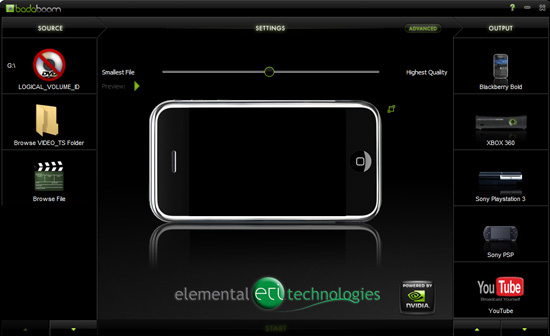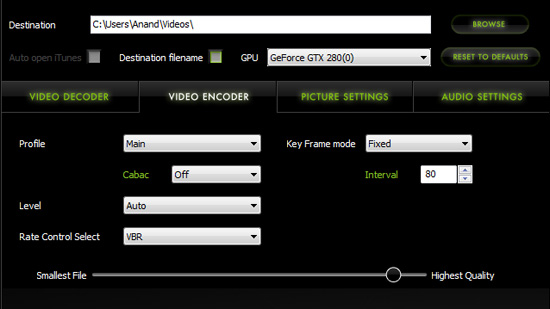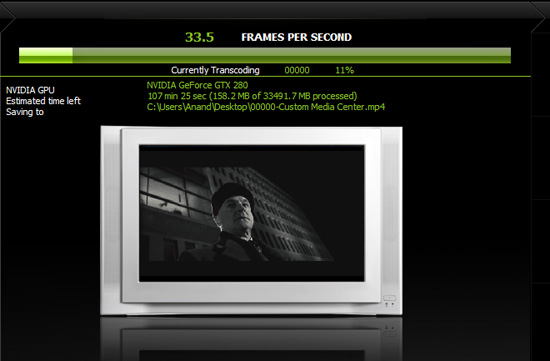GPU Transcoding Throwdown: Elemental's Badaboom vs. AMD's Avivo Video Converter
by Anand Lal Shimpi & Derek Wilson on December 15, 2008 3:00 PM EST- Posted in
- GPUs
Badaboom 1.1 Preview
Elemental was nice enough to get us a preview build of Badaboom 1.1, due out in the next week or so.


The 1.1 release is pretty significant, arguably just as significant as 1.0 given the list of improvements:
This version offers additional input files, including DivX, Xvid, VC-1, and MKV. The file formats in 1.0 are still supported.
- H.264 Main profile output.
- 1920x1080 (1080p) output.
- New output profiles: Blackberry Bold, YouTube, and Zune.
- Multi-GPU capability: Badaboom can now let you select which CUDA-enabled GPU to run the transcoding on in the Advanced options. You can open multiple Badaboom applications and run different video files simultaneously on different GPUs, seeing similar high performance as you see with running Badaboom now. For example, two NVIDIA GPUs can transcode two movies in the time it would take Badaboom 1.0 to transcode one. For this initial version, there are a couple caveats:1. SLI must be disabled (if it is enabled) .
2. Each GPU needs to be connected to a display.
3. Each GPU must have a desktop enabled on it.
I’m not particularly interested in the multi-GPU support that 1.1 offers given the caveats, but the rest of the feature list is excellent. With DivX support you can now take your old DivX shows and movies, re-encode them using Badaboom to save space. While trying to transcode a DivX file in the early version of Badaboom failed miserably, it worked just fine in the 1.1 preview.

oh wow, real settings
Main profile with CABAC support is also enabled, making Badaboom 1.1 closer to a real alternative for high quality rips of DVDs and Blu-rays. The 1.1 beta isn’t ready for prime time but I wanted to see what it could do, so I grabbed my Casino Royale Blu-ray, ripped it to the hard drive (resulting in a 46GB iso). The Blu-ray file structure is pretty straightforward, in the \BDMV\STREAM directory you’ll find a bunch of m2ts files, in this case the 34GB 00000.m2ts file is the main 1080p movie.

Please don't throw me in jail
Since I just ran the BD through AnyDVD HD it no longer had any encryption thus Badaboom was ok with transcoding it. To my surprise, it just worked. Using the Custom Media Center profile I was able to select a video bitrate of up to 25Mbps, I stuck with 11Mbps which should be enough for most < 50” HDTVs and normal viewing distances. The maximum audio bitrate is 320kbps, which is what I selected for the transcode. The resulting file was an 11.4GB .mp4 file that took 2 hours and 2 minutes to transcode at an average of 28.3 fps (note that this included the credits as well) on a GeForce GTX 280.
The Blu-ray original was mastered at 24 fps, so with Badaboom on a GTX 280 we can get greater than real-time transcoding.
Delivering as promised, Elemental also enabled 1080p output with Badaboom 1.1. While I suspect that most people using to backup their Blu-ray collection will choose to go down to 720p since you can basically cut file sizes in half and maintain good enough quality for most HD displays.

The biggest limitation I see is that the output file is relatively useless on a HTPC. While Badaboom can provide a quick and easy way to rip a Blu-ray to a smaller, more backup-friendly format, you do lose the ability to preserve the DD/DTS audio tracks. Forget about lossless 7.1 support, I’m just talking about maintaining basic DD/DTS 5.1 that your HTPC/receiver are already setup to play.
Elemental still dodges the bullet of having to be a real Blu-ray backup solution by not addressing the audio side of the equation, but it’s clear where Badaboom is headed. I’m still looking into how well it fares on the image quality side compared to x264, but for now it looks like Badaboom 1.1 has potential in this department.
The real competition will be Intel’s Core i7 which, thanks to its incredible encoding performance can actually do quite well in the HD transcode department. NVIDIA has the advantage of its GPUs being much cheaper (you don’t have to buy a whole new platform) but at least at this point Intel has the quality advantage given that the best audio/video transcoding tools on the market are still x86-only and without a CUDA counterpart.











36 Comments
View All Comments
plonk420 - Tuesday, December 16, 2008 - link
this review is irksome... no mention of x264 version, no mention of resolution or bitrate used on the chart. as a previous comment says, the PQ on the x264 encode looks like the resize was screwed up... the comparison to a software solution was pretty poor.plonk420 - Tuesday, December 16, 2008 - link
http://plonkmedia.org/demo/test.html">http://plonkmedia.org/demo/test.html <-low resolution stream (zoomed 2x)http://www.megaupload.com/?d=ECOIUXQL">http://www.megaupload.com/?d=ECOIUXQL <-low resolution download
http://www.megaupload.com/?d=TPJVM0Y6">http://www.megaupload.com/?d=TPJVM0Y6 <-high resolution
http://www.viddler.com/explore/plonk420/videos/1/">http://www.viddler.com/explore/plonk420/videos/1/ <-what i'm assuming is a transcode (but same site that Anandtech used)
plonk420 - Tuesday, December 16, 2008 - link
quick and dirty tests... (emphesis on dirty; i have Opera with 30+ tabs open, uTorrent, VNC Viewer, handful of other programs open)source: Star Wars 4 VTS_02_4, 18 mins
low res: 320x128 took 310 seconds (±10 sec), processor use was ~30-40%
high res: 640x272 took 325 seconds (±10 sec), processor use was 60-70%
bicubic resizing, no cropping to exactly 2.39:1; couldn't be arsed. just used MeGUI's default iPod encoding settings, but set Quant 19. did SubME 2, 4, 5, and one test with 6 (the high res). it didn't seem to change the time it took to encode.
i'm sure you could up quality, significantly, too with better resizing options (i ususally use Lanczos4), other iPod compatible switches, at minimal speed cost. i don't usually encode for low bitrate/PMPs, but settings to do so are a google away.
but this pq looks decent to me. no issues the hardware encode had. using x264 has a BIT of a learning curve, but can be as fast as these hardware solutions (and possibly excede PQ with the proper options). recent builds have Peryn, i7, and even Phenom optimizations (that weren't utilized in one of the other site's i7 x264 tests).
my tests were encoded on a "mere" Phenom 9550 @ 2.2ghz on Vista x64 SP1, drives fragmented to hell.
options were --qp 19 --level 3 --nf --no-cabac --partitions none --merange 12 --threads auto --thread-input --progress --no-psnr --no-ssim (with --level being 1.3 for low or 3 for high, and --subme being 2, 4, 5, 6). build was 1051 (a few builds out of date; 1055 has better CAVLC PQ according to changelog)
mvrx - Monday, December 15, 2008 - link
I've been grumpy about this for years. Most all the commercial video editing packages have treated mananging and encoding 1080p as a pro-only, or "coming next year" feature.. 1080p isn't pro folks. It's consumer level.I have to use StaxRip with x264.exe encoder to do what I really want, as most commericial packages still have issues with 1080p. Everything should be ready for any resolution, including super high def. Don't try to charge customers more just because they are ready for what will be considered common in another year or two.
I'd also like to see the upconverting technolologies that HD dvd/BR players do in real time mature for software converters. I'd like to take my home movies and DVDs and convert them to 1080p, then encode to h.264. I know that doesn't give me true native quality content, I just like the idea of standardizing all my media to 1080p.
MadMan007 - Monday, December 15, 2008 - link
Thanks for keeping up with these articles. GPGPU's killer app for most consumers is video encoding. One thing that's missing from this article as was alluded to by an earlier comment is a reasonable price comparison - I'd like to see how the GPGPU encoders stack up to a dual core CPU since adding a video card is a much easier upgrade and lots of people have dual core CPU systems already.psychobriggsy - Monday, December 15, 2008 - link
It's interesting comparing this review to the Avivo vs Badaboom article I read elsewhere earlier this month (using the leaked pre-release Catalyst) where they achieved significant performance improvements over using a CPU (i.e., it was actually encoding on the GPU in that review, whereas the conclusion here is that it isn't). They didn't use a Core i7 however. Still, when it comes to using a $200 video card with a $200 CPU, or a $1000 CPU to achieve the same thing, the choice is obvious (well, when the quality is sorted out).Regardless AMD really shouldn't have released Avivo in that state, or they could have at least just called it a preview. What's wrong with AMD/ATI's developers? Don't they have any pride in their work?
bobsm1 - Tuesday, December 16, 2008 - link
Looks like Anand is actually reviewing the products instead of taking the marketing crap that is being provided and just posting it. Takes a bit more work but the result is more interestingdaletkine - Tuesday, December 16, 2008 - link
I used my Sapphire Toxic 4870 to convert the MPEG2 recording of Lost in Space VCR tape, to DivX using Avivo Video converter. My size went from 5.10GB to 3.48GB, from 720x480 (12Mbps) to 640x480 (converter doesn't give res options). Speed wasn't drammatic, like around 40min for 2h10min movie, on an Athlon 64 X2 @ 3.23GHz. CPU was utilized 100% and GPU was utilized (can be seen with RivaTuner) around 8-10%. Video quality was great, nothing to complain, no artifacts like anand pointed out, looks fine. So, seems to have worked for me, but not what I expected. The bad: WMV displays artifacting just like anand showed, Catalyst 8.12 drivers have issue with Xvid stuttering playback, so I saw that in WMP when playing my converted file (solved by using VLC player), no compression that I can see taking place (I used max quality setting, but medium only gives savings of 500MB, don't know about low), and it still needs a quad core.The good: it actually works for me, free, simple, good quality (when works).
This on Vista 64, 8GB ram, Athlon 64 X2 5000+ @ 3.23GHz.
Jovec - Monday, December 15, 2008 - link
8.12 Avivio just creates a 0 byte file when trying to transcode my Xvid (AutoGK) videos. Ah well...Etsp - Monday, December 15, 2008 - link
Man, that's some high level of compression. Careful with that, it may just have made an information black-hole on your hard-drive. :)